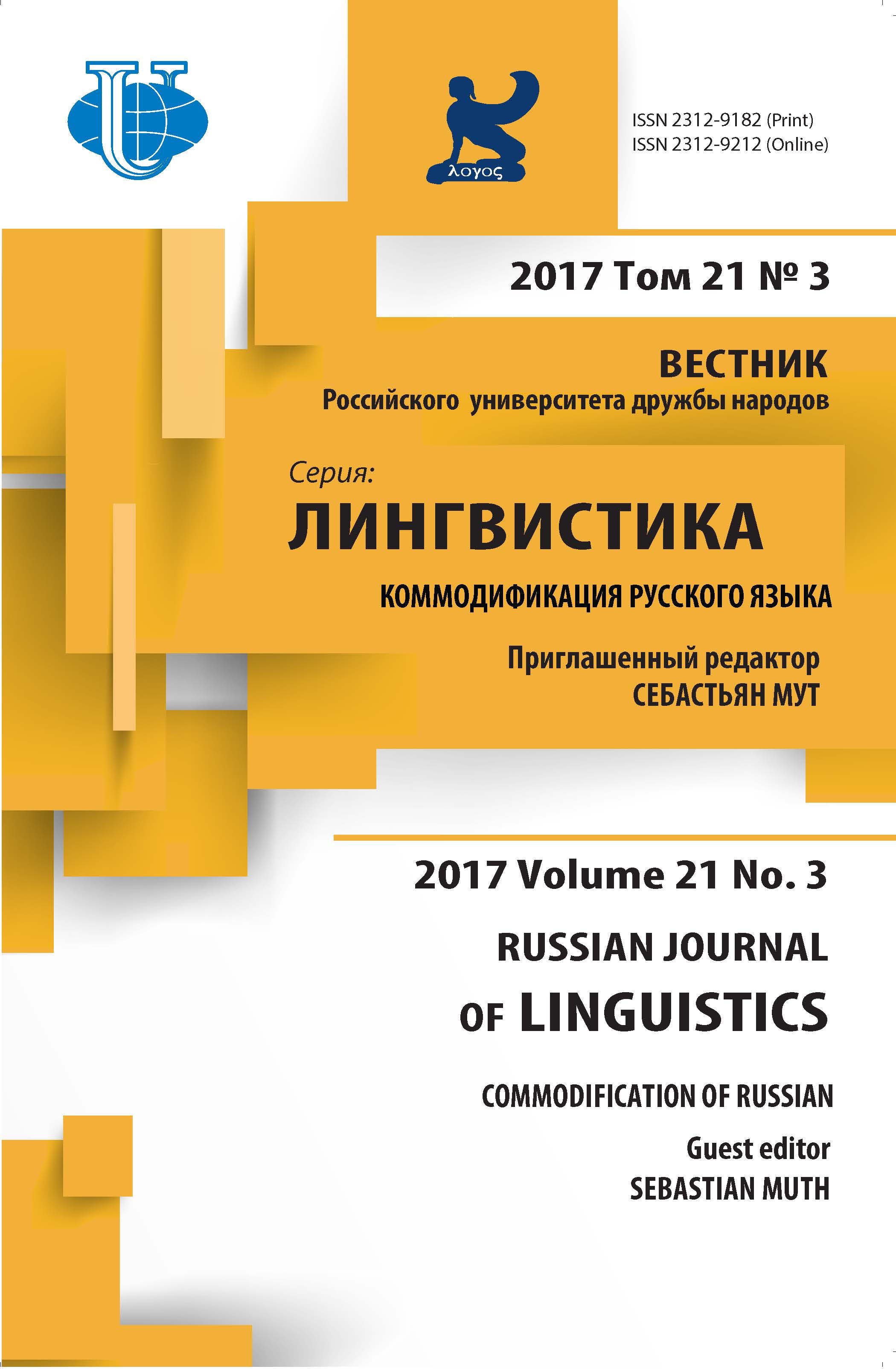THE ROLE OF THE RUSSIAN LANGUAGE IN INDIA’S HEALTHCARE SECTOR
- Authors: Suryanarayan N.1
-
Affiliations:
- University of Delhi
- Issue: Vol 21, No 3 (2017): Commodification of russian
- Pages: 515-529
- Section: Articles
- URL: https://journals.rudn.ru/linguistics/article/view/16789
- DOI: https://doi.org/10.22363/2312-9182-2017-21-3-515-529
Cite item
Full Text
Abstract
Keywords
About the authors
Neelakshi Suryanarayan
University of Delhi
Email: neelakshi55@yahoo.co.in
Neelakshi Suryanarayan, Phd, Professor, Head of the Department of Slavonic and Finno-Ugrian Studies, Delhi University, India. A graduate of the Peoples’ Friendship University of Russia, she teaches Russian language, literature and cultural studies. She is a member of the international scientific network of ENIEDA and other professional and scientific associations, as well as the editorial boards of scientific journals, including the “The Russian Journal of Linguistics”. Research interests: comparison of speech etiquette in Indian languages, Russian and English, pragmatics, commodification of the Russian language in the 21st century. Delhi University, 110007 Delhi, India
References
- Babu, P. G., and Anjaneya Swamy, G. (2007) Medical Tourism: An analysis with special reference to India. Journal of Hospitality Application and Research, 2, 1: 31-48.
- Chuang, T. C., Liu, J. S., Lu, L. Y. Y., & Lee, Y. (2014) The main paths of medical tourism: From transplantation to beautification. Tourism Management 45, 49-58.
- Coulmas, F. (2005) Changing language regimes in globalizing environments. International Journal of the Sociology of Language, 175/176: 3-15.
- Connell, J. (2013) Contemporary Medical Tourism: Conceptualisation, Culture and Commodification. Tourism Management, 34: 1-13.
- Connell, J. (2015) Transnational health care: Global markets and local marginalisation in medical tourism. In P. Bronwyn, B. Greenhough, T. Brown, and I. Dyck (eds.) Bodies across borders: The global circulation of body parts, medical tourists and professionals. Farnham: Ashgate, 75-94.
- Crooks, V. A., Turner, L., Snyder, J., Johnson, R., and Kingsbury, P. (2011) Promoting Medical Tourism to India: Messages, Images, and the Marketing of International Patient Travel. Social Science and Medicine, 72: 726-732.
- Duchêne, A. (2009) Marketing, management and performance: Multilingualism as commodity in a tourism call centre. Language Policy 8: 27-50.
- Duchêne, A. (2011) Néolibéralisme, inégalités sociales et plurilinguismes: l’exploitation des ressources langagières et des locuteurs. Langage & Société, 136: 81-106.
- Harvey, D. (1989) The Condition of Postmodernity: An Enquiry into the Origins of Cultural Change. Oxford: Wiley-Blackwell.
- Heller, M. (2003) Globalization, the New Economy, and the Commodification of Language and Identity. Journal of Sociolinguistics, 7 (4): 473-492.
- Heller, M. (2010) The Commodification of Language. Annual Review of Anthropology, 39: 101-114.
- Heller, M., and Duchêne, A. (2012) Pride and Profit: Changing Discourses of Language, Capital and Nation State. In A. Duchêne, and M. Heller (eds.) Language in Late Capitalism: Pride and Profit. New York and London: Routledge, 1-21.
- Heller, M. and Duchêne, A. (2016) Treating language as an economic resource: Discourse, data, deba¬tes. In N. Coupland (ed.) Sociolinguistics: Theoretical Debates. New York: Cambridge Univer¬sity Press, 139-156.
- Jones, C. A., and Keith, L. G. (2006) Medical Tourism and Reproductive Outsourcing: The Dawning of a New Paradigm for Health-care. International Journal of Fertility and Women’s Medicine, 51: 251-255.
- Kaspar, H. (2015) Private hospitals catering to foreigners underestimate interpreters' role. Hindustan Times. Retrieved from: http://www.hindustantimes.com/ht-view/private-hospitals-catering-to-foreigners underestimate-interpretersrole/storyqqE4UDCcB6b0EaW8TyuOQN.html
- Milstein, A., and Smith, M. (2006) America‘s New Refugees - Seeking Affordable Surgery Offshore. New England Journal of Medicine, 355: 1637-1640.
- Muth, S. (2017) Russian as a commodity: medical tourism and the healthcare industry in post-Soviet Lithuania. In S. Muth and L. Ryazanova-Clarke (eds.) The commodification of Russian around the world (Special issue). International Journal of Bilingual Education and Bilingualism, 20(4): 404-416.
- Ollapally, D. (2002) Indo-Russian Strategic Relations: New Choices and Constraints. Journal of Stra¬tegic Studies 25 (4): 135-156.
- Pant, H. V. (2013) India-Russia Ties and India’s Strategic Culture: Dominance of a Realist Worldview. India Review, 12 (1): 1-19.
- Pavlenko, A. (2012) Commodification of Russian in post-1991 Europe. In M. Bär, A. Bonnet, H. Pav¬lenko, A. (2013) Language management in the Russian empire, Soviet Union, and post-Soviet countries. In R. Bayley, R. Cameron, and C. Lucas (eds.) The Oxford Handbook of Socio-lin¬guistics. Oxford: Oxford University Press, 651-679.
- Pavlenko, A. (2017) Russian-friendly: how Russian became a commodity in Europe and beyond. In S. Muth and L. Ryazanova-Clarke (eds.) The commodification of Russian around the world (Special issue). International Journal of Bilingual Education and Bilingualism, 20(4): 385-403.
- Tan, P, and Rubdy, R. (2008) (eds.) Language as Commodity: Global Structures and Local Market¬places. London: Continuum.
- Sahai, S. (1990) The Delhi Declaration: Cardinal of Indo-Soviet Relations. New Delhi: Mittal.
- Suryanarayan, N. (2017) From Yashwant Place to Yashka: a case study of commodification of Russian in India. In S. Muth and L. Ryazanova-Clarke (eds.) The commodification of Russian around the world (Special issue). International Journal of Bilingual Education and Bilingualism, 20(4): 428-442.
- Viladrich, A., and Baron-Faust, R. (2014) Medical Tourism in Tango Paradise: The Internet Branding of Cosmetic Surgery in Argentina. Annals of Tourism Research, 45 (3): 116-131.

















